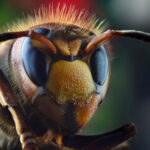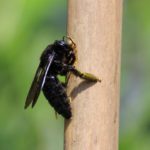When I’m outdoors savoring the sunny delights of a backyard barbecue or enjoying the serene ambiance of a garden picnic. I often find myself in the company of inquisitive bumble bees. Attracted by the tantalizing aromas, these fuzzy visitors may seem like they’re out to buzz right into my business. But what’s really on their minds? Let’s dive into the captivating world of bumble bee behavior to unravel the mystique of their sting habits and discover. What truly drives these fascinating creatures?
Show a bumblebee collecting nectar from a flower, while another bee stands guard nearby.
In my quest to understand whether do bumble bees sting, I learned that these creatures are typically more focused on. Their survival task of feeding their lightning-fast metabolism rather than disrupting our outdoor affairs. The vibrant spectrum of their colors, not just the stereotype of black and yellow. But also the shades of orange and white stripes are a testament to their diversity. But rest assured, the bumble bee’s approach is as non-aggressive as their kaleidoscope is broad, only resorting to their stinger in rare cases of perceived significant threat.
Table of contents
An Introduction to Bumble Bees and Their Behavior
As I delve into the intricate world of bumble bees. It’s fascinating to notice that their existence is not solely characterized by the common black and yellow. Markings we often associate with them. Their bustling lives are driven by an intense need to feed a remarkably quick metabolism. Which propels them to persistently gather and consume nectar. The array of colors and the hustle of their daily foraging are essential threads in the tapestry of our ecosystems.

The Fuzzy Facts: Not Just Black and Yellow
When it comes to bumble bee identification. The palette of bumble bee color patterns is more diverse than one might expect. In addition to black and yellow, these aerial entrepreneurs can sport vivid shades of orange and even crisp white stripes. The Bombus Dahlbomi, or as some might whimsically call it, the ‘flying mouse,’ showcases this diversity impressively with its sizeable stature and furry appearance.
Bumble Bees’ Appetites and Metabolism
The bumble bee metabolism is a spectacle of nature’s efficiency. Operating at an accelerated pace, these industrious insects are in a perpetual state of dining to stave off starvation, sometimes just 40 minutes removed from an empty stomach. This internal engine demands constant fueling, propelling them to tirelessly forage diverse flora as an integral part of their survival and our natural world.
Understanding the Bumble Bees Sting
Whenever I’m out in my garden or enjoying an alfresco meal, I often encounter bumble bees, prompting me to wonder, do bumble bees sting? While renowned for their fuzzy appearance and busy foraging habits, the sting of a bumble bee is quite uncommon. Typically, a bumble bee will only resort to using its sting as a defensive act when it feels directly threatened or its nest is disturbed.
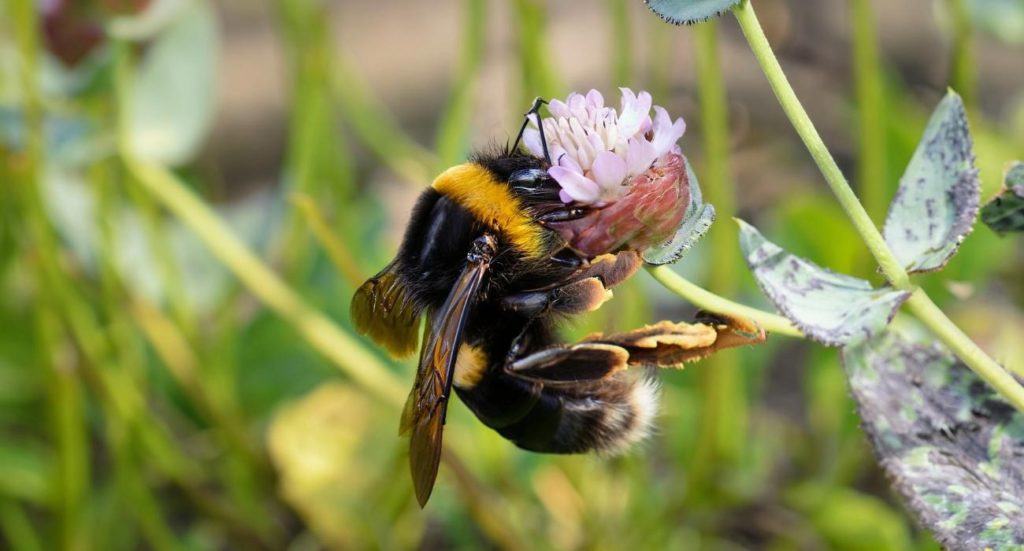
To reduce the risk of an unwelcome sting, bumble bee sting prevention strategies are simple yet effective. For example, avoiding the disturbance of their nests and moving slowly and calmly around these creatures significantly minimizes any potential for provocation. It’s just as essential to educate others on these habits, ensuring a harmonious coexistence with these industrious pollinators.
However, if a sting occurs, treating a bumble bee sting promptly and correctly is critical to alleviate the pain and prevent further complications. The steps I take for addressing bumble bee stings are straightforward, focused on removing the stinger if necessary and applying aftercare techniques to soothe discomfort.
Here’s a guide to ensure you’re equipped with knowledge on treating a sting:
| Action | Explanation | Benefit |
|---|---|---|
| Scrape Away Stinger | Use a fingernail or credit card edge to scrape off the stinger | Limits the spread of venom into the skin |
| Apply Cold Compress | Use a cloth-wrapped ice pack on the sting site | Reduces pain and swelling |
| Monitor for Allergies | Watch for signs of an allergic reaction after a sting | Ensures timely medical response if necessary |
| Over-the-Counter Solutions | Consider antihistamines or pain relievers as directed | Alleviates itching, redness, and discomfort |
While the possibility of encountering a sting from a bumble bee remains low, having the knowledge and tools for treating a bumble bee sting gives me peace of mind. After all, most bumble bees are far more interested in the next flower than in stinging anyone. Should you be among the small percentage of individuals who experience an allergic reaction, immediate medical intervention is paramount.
Finally, it’s worth noting that these creatures, while capable of stinging us, perform an indispensable role in the health of our environment. By treating them with respect and caution, we can both prevent stings and encourage their necessary pollination work. For me, understanding the nature of do bumble bees sting and how to coexist safely with these essential insects is yet another reason to marvel at and appreciate the world around us.
Male Bumble Bees and the Stinger Story
As I’ve come to learn about the buzzing inhabitants of my garden, it’s clear that not all bumble bees are created equal, particularly when it comes to their capacity to sting. When faced with one of these furry insects, it’s important to remember that male bumble bees simply can’t sting. Unpacking the whys and wherefores of this fact tells a broader story about their role in the ecosystem and can help put to rest any worries you might have about these gentle male pollinators.
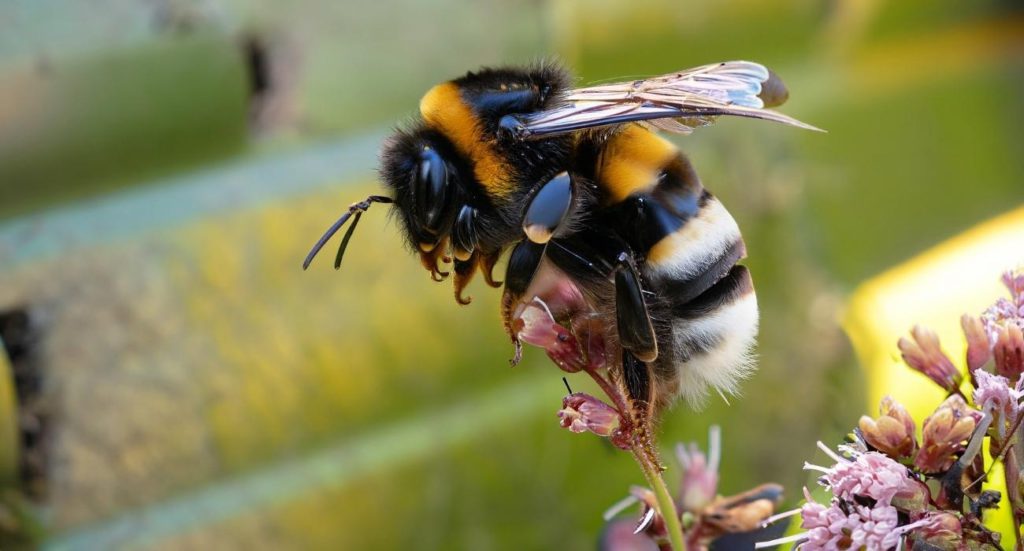
Why Male Bumble Bees Don’t Pose a Stinging Threat
In studying the behavior of these creatures, I found out that male bumble bees lack the notorious bumble bee stinger altogether, rendering them incapable of defending themselves in the classic bee-like fashion. This absence of weaponry means they are a trait of peace in the garden; their purpose lies elsewhere than in colony defense or aggression.
Identifying Male vs. Female Bumble Bees
When walking through my blooms and blossoms, I often stop to observe the bumble bees at work. I’ve become quite adept at distinguishing bumble bee gender, noting the presence or lack of certain key characteristics. For anyone looking to differentiate between the males and females, it’s all about checking for the pollen basket. Female bumblebees come equipped with these specialized structures for carrying pollen back to the nest, while males do not.
Understanding these differences is essential not only for gardeners and naturalists but also for anyone with an interest in the thriving ecosystems that depend on these crucial pollinators. And for anyone still on edge about the possibility of being stung, rest assured that spotting a male bumble bee means you’re in no threat from a sting. Here’s a simple table to help with identification:
| Characteristic | Male Bumble Bee | Female Bumble Bee |
|---|---|---|
| Pollen Basket | Absent | Present |
| Stinger | Absent | Present |
| Role in Colony | Mating with New Queens | Pollen and Nectar Collection, Nest Maintenance |
| Size | Typically Smaller | Larger, Especially Queens |
I find it utterly fascinating how these insects have evolved such distinct roles and characteristics, allowing them to continue their vital work of pollination without the worrisome concern of a sting in the mix. Whether it’s a male bumble bee clumsily hovering from petal to petal or a busy female worker collecting nectar, the garden is a dance of diverse dynamics and duties that I’m privileged to witness.
The Anatomical Peculiarities of Bumble Bees
Diving into the captivating intricacies of bumble bee anatomy, I’ve uncovered a fascinatingly unique blueprint that defines these vital pollinators. Unlike any textbook depiction of animal circulatory systems I’ve seen, bumble bees have a remarkable alternative to veins and arteries. Additionally, the eyesight of these creatures, comprised of multiple eyes, lends an almost alien look to their charmingly fuzzy faces. Together, these features contribute greatly to their effectiveness within the plant kingdom and their endurance within diverse environmental conditions.
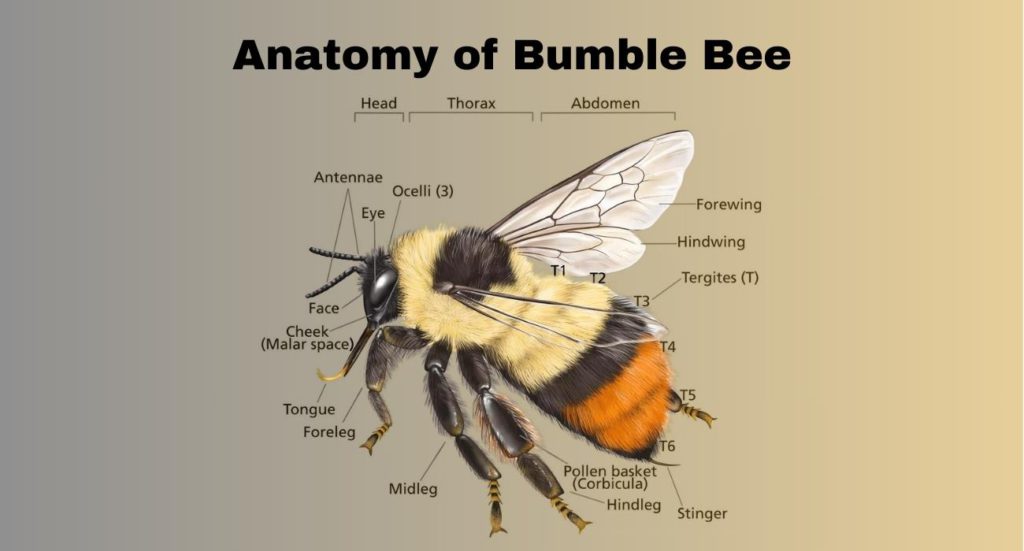
A Unique Circulatory System: No Veins or Arteries
In exploring the bumble bee circulatory system, I am in awe of how nature crafts solutions that defy human-based expectations. Bumble bees do not have the vein and artery networks that shuttle blood through our bodies. Instead, their internal organs float in a shared pool of blood, relying on the pumping action of a single long tube to circulate their life-sustaining fluids. This system may seem primordial, but it’s a streamlined process that keeps these little flyers buzzing efficiently from flower to flower.
Bumble Bee Vision: The Power of Five Eyes
My fascination with bumble bee eyesight grows as I delve deeper into their ocular capabilities. With a total of five eyes, bumble bees possess three simple eyes on the top of their head and two large compound eyes at the front. This anatomical gift enables them to detect ultraviolet light, crucial for locating flowers and determining the availability of nectar, hence guiding their preference for flowers oozing with sweet sustenance. Interestingly, despite their expansive visual range, they can’t perceive the color red, rendering certain blossoms invisible to their gaze. This selective vision ensures that bumble bees spend their energy wisely on the most rewarding of nature’s floral offerings.
Click here to read how can bees fly at night.
FAQ
Q1. Do bumble bees sting?
Yes, bumble bees can sting, but they often reserve their stingers for situations in which they feel their nest or themselves are under threat. Unlike honey bees, bumble bees can sting more than once because their stingers lack barbs.
Q2. What is typical bumble bee behavior?
Bumble bees are typically focused on foraging for food to sustain their rapid metabolism. They are not naturally aggressive and will rarely initiate a confrontation unless they feel endangered.
Q3. How can I identify different types of bumble bees?
Bumble bees come in various color patterns, including the common black and yellow, as well as orange and white. You can identify them by their size, color, and the presence of a pollen basket on the females.
Q4. Are there bumble bees that do not sting?
Yes, male bumble bees are unable to sting because they lack a stinger entirely. They’re harmless to humans and are identified by their lack of a pollen basket, which is present in female bumble bees.
Q5. How should I treat a bumble bee sting?
To treat a bumble bee sting, you should remove the stinger carefully, apply a cold compress to reduce swelling and consider taking an antihistamine or pain reliever if necessary. If there are signs of an allergic reaction or severe symptoms, seek medical attention immediately.
Q6. How do bumble bees differ anatomically from other insects?
Bumble bees have a unique anatomical structure. They don’t have veins or arteries; instead, their blood flows openly within their body cavity, circulated by a long tube. Additionally, they have five eyes, three ocelli on top of their head, and two larger compound eyes that allow them to see ultraviolet light but not red.
Q7. How do bumble bees see the world around them?
Bumble bees have excellent vision that enables them to detect ultraviolet light, which many flowers reflect. However, they are red-blind and cannot see the red spectrum. This vision assists them in locating and distinguishing flowers that are rich in nectar.
Q8. What is the diet of a bumble bee?
Bumble bees need to eat frequently due to their high metabolism. They primarily feed on nectar and pollen collected from flowers, which provides them with the energy necessary for their activities and the sustenance of their colonies.
Q9. Can bumble bees control the temperature of their nests?
Yes, bumble bees have the ability to regulate the temperature within their nests. They use different techniques such as fanning their wings. Or adjusting the rate of their body’s heat production to maintain a suitable temperature for incubating their brood. Click here to read marvels of bee wings.
Q10. What is the biggest bumble bee species?
The biggest bumble bee species is Bombus dahlbomii, commonly found in South America. Its large size has given it the nickname “flying mouse.”
Stay Tuned to Insect Insider for all insects-related articles.


